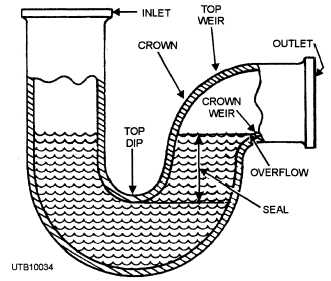Q13. For an air test to be satisfactory, the system should hold 5 psi for what period of time?
Q14. What type of oil should be used for an odor test?
Ql5. A manhole should be what diameter at the sewer level?
Ql6. Earth fill should be placed in the trench over the pipe in layers of what thickness?
ABOVEGROUND SANITARY PIPING
LEARNING OBJECTIVE: Identify pipe, traps, vents, and installation methods for aboveground sanitary drainage.
After the underground piping is installed for a sewer system, the next phase is to install the aboveground piping. Information on materials applicable to the installation of aboveground sewage piping is provided in the following sections. Installation procedures are the same for aboveground and underground sewer pipe.
TYPES OF PIPE
A number of different types of pipes are used in the aboveground and interior parts of a plumbing system. Some of the common types of pipes are discussed briefly below.
While GALVANIZED WROUGHT-IRON PIPE is an excellent material for aboveground plumbing, it is costly. It is available in lengths from 18 to 22 feet. Galvanized wrought-iron pipe is constructed of wrought iron dipped in molten zinc to protect it from corrosion and provide high resistance to acid waste.
ACID-RESISTANT CAST-IRON PIPE is composed of an alloy of cast iron and silicon. It is used to serve chemical laboratories and other installations through which acid waste flows. In handling acid- resistant pipe, such as Durion, be careful because it is very brittle and cracks easily. It is cast in 5-foot lengths and comes in single and double hubs.
BRASS PIPE consists of an alloy of zinc and copper. Brass pipe has a smooth interior and can resist most acids; however, it is expensive. It is available in 20-foot lengths; because it tends to bend, it must be supported at intervals of 8 to 10 feet.
LEAD or LEAD-LINED STEEL PIPE is sometimes used to carry distilled water for batteries; however, tin-lined, block tin, glass, or some types of plastic pipe must be used where no impurities are acceptable. Because it bends easily, lead pipe must be well-supported. It is available in three weights: (1) standard, (2) common, and (3) extra heavy. The standard weight is most commonly used.
COPPER PIPE. is suitable for use in waste, vent, and water installations. Remember that ammonia and water corrode copper and bronze lines. Also, when copper is used for waste pipe installations, always make sure it is rigid to overcome sagging. You can obtain the pipe in convenient lengths, then cut it to size for the job at hand.
PLASTIC PIPE is also suitable for use above- ground for sewage, venting, and water.
TRAPS
A number of different types of traps are available; however, the trap most commonly used with plumbing fixtures is the P-trap (fig. 3-34). Traps are required because they prevent sewer gases from entering a building and causing serious illness or death.
The term trap seal refers to the water being held in the bent portion of a fixture trap (fig. 3-34). True to its name, the trap seal forms a seal against the passage of sewer gases through the trap and into the building. The most frequently used seal trap has a depth of 2 inches between the overflow and the dip. The deep seal trap has a depth of 4 inches.
The P-trap gets its name because of its general shape-that of the letter P. It comes in sizes from 1 1/4 to 6 inches in diameter. Various types of P-traps are available, so designs may differ from one manufacturer to another. The P-trap is usually made

Figure 3-34. - P-trap.
Continue Reading